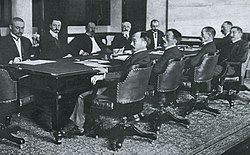Empirical measures
Money is used in final settlement of a debt and as a ready store of value. Its different functions are associated with different empirical measures of the money supply. Since most modern economic systems are regulated by governments through monetary policy, the supply of money is broken down into types of money based on how much of an effect monetary policy can have on each. Narrow measures include those more directly affected by monetary policy, whereas broader measures are less closely related to monetary-policy actions.[6]Each measure can be classified by placing it along a spectrum between narrow and broad monetary aggregates. The different types of money are typically classified as Ms. The number of Ms usually range from M0 (narrowest) to M3 (broadest) but which Ms are actually used depends on the system. The typical layout for each of the Ms is as follows:
- M0: Notes and coins (currency) in circulation and in bank vaults.[8] In some countries, such as the United Kingdom, M0 includes bank reserves, so M0 is referred to as the monetary base, or narrow money.[9]
- MB: Equals M0 + reserves which commercial banks hold in their accounts with the central bank (minimum reserves and excess reserves). MB is referred to as the monetary base or total currency.[10] This is the base from which other forms of money (like checking deposits, listed below) are created and is traditionally the most liquid measure of the money supply. [11]
- M1: M1 includes funds that are readily accessible for spending. M1 consists of: (1) currency outside Federal Reserve Banks, and the vaults of depository institutions; (2) traveler's checks of nonbank issuers; (3) demand deposits; and (4) other checkable deposits (OCDs), which consist primarily of negotiable order of withdrawal (NOW) accounts at depository institutions and credit union share draft accounts. [12] Bank reserves are not included in M1.
- M2: Equals M1 + savings deposits, time deposits less than $100,000 and money market deposit accounts for individuals. M2 represents money and "close substitutes" for money.[13] M2 is a broader classification of money than M1. Economists use M2 when looking to quantify the amount of money in circulation and trying to explain different economic monetary conditions. M2 is a key economic indicator used to forecast inflation.[14]
- M3: Equals M2 + large time deposits, institutional money-market funds, short-term repurchase agreements, along with other larger liquid assets.[15] M3 is no longer published or revealed to the public by the US central bank.[16] However it is estimated by the web site Shadow Government Statistics. [17]
- MZM: Money with zero maturity. This measure equals M2 plus all money market funds, minus time deposits. It measures the supply of financial assets redeemable at par on demand.

